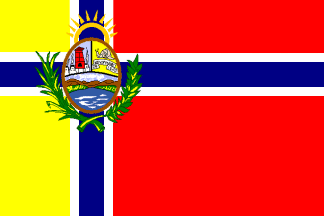 klaus-michael schneider
klaus-michael schneider
Keywords: aragua | sucre | cagua |
Links: FOTW homepage | search | disclaimer and copyright | write us | mirrors

Last modified: 2021-08-26 by  klaus-michael schneider
klaus-michael schneider
Keywords: aragua | sucre | cagua |
Links: FOTW homepage |
search |
disclaimer and copyright |
write us |
mirrors
 (2:3)
(2:3)
by Blas Delgado Ortiz, 26 April 2002
See also:
The flag of the municipality of Sucre (capital: Cagua), in
Aragua Department, Venezuela. The image is based on a
recent color pencil drawing sent to Venezimbol. I assumed the
flag to be 3:2, as the other Venezuelan city flags.
Blas Delgado Ortiz, 26 April 2002
Néstor Garrido made me aware that this Sucre (a name much
used in great part of South America) is the "Municipality of
Sucre", that has the city of Cagua as its capital, and is in
the Department of Aragua, Venezuela.
Blas Delgado Ortiz, 28 April 2002
FLAG OF THE MUNICIPALITY OF SUCRE, STATE OF ARAGUA:
COLOURS:
YELLOW: It represents the wealths and the economic potential of
the municipality.
RED: It represents the blood spilt by the inhabitants of Cagua
when the war of Independence explodes, when the as the Spanish
commanders Zuazola and Jose Tomás Boves beheaded the cagüenses,
who could not flee.
BLUE: It represents the water wealth of the municipality,
principally Taiguaiguai's lagoon, the river Aragua and
Tamborón's gully.
THE INTERLACED STRIPING: They represent the privileged
geographical position of the municipality of Sucre, in the very
heart of Aragua and of Venezuela, where there converge the roads
that go to the principal cities of the country, as Caracas,
Valencia and Maracay, as well as it is the door of entry par
excellence to the Venezuelan plains.
THE EMBLEM (OR COAT OF ARMS):
EDGE: The edge that frames the emblem (or coat of arms) is of
brown color (chestnut-colored), in representation of the wealth
of the soils of the municipality.
SPIKES: They are of cotton and cane of sugar, agricultural items
that, together with the indigo, were the first sources of wealth
of the municipality.
LOW BARRACK: The Taiguaiguai's beautiful lagoon is represented,
between Cagua and Villa de Cura; in spite of its great
tourist value, it has been little exploited. Also it is rich in
flora and fauna.
TOP LEFT BARRACK: There is represented, at the bottom, the
torreón of the Toro family, used as chimney to the boilers of
the first industry founded on Cagua in 1876; in the first plane
there are represented the companies that have led to the
municipality to be considered as a real industrial emporium,
probably more densely populated in the center of the country.
Also there are represented other places and monuments considered
as colonial jewels, of special importance for the municipality
Sucre, as the Municipal House, the Casa del Alto (former
headquarters of the Guipuzcoa Company), the Mill of Stone, the
House of the Culture and the Museum of Art and History, among
others.
TOP STRAIGHT BARRACK: It symbolizes the foundation of the city of
Cagua, which name comes from the aboriginal word
"caguacao", derived of "cahihua": snail; and
"cao", creek. The band establishes the date of
elevation to parish, on November 29, 1620, with the name of San
José de Cagua.
TOP PART OF THE EMBLEM (COAT OF ARMS): There is the halo of the
holy sponsor of Cagua, Saint Joseph.
Pablo Acosta Ríos, 14 May 2002
d-suc.gif)
from <www.siga.sian.info.ve>